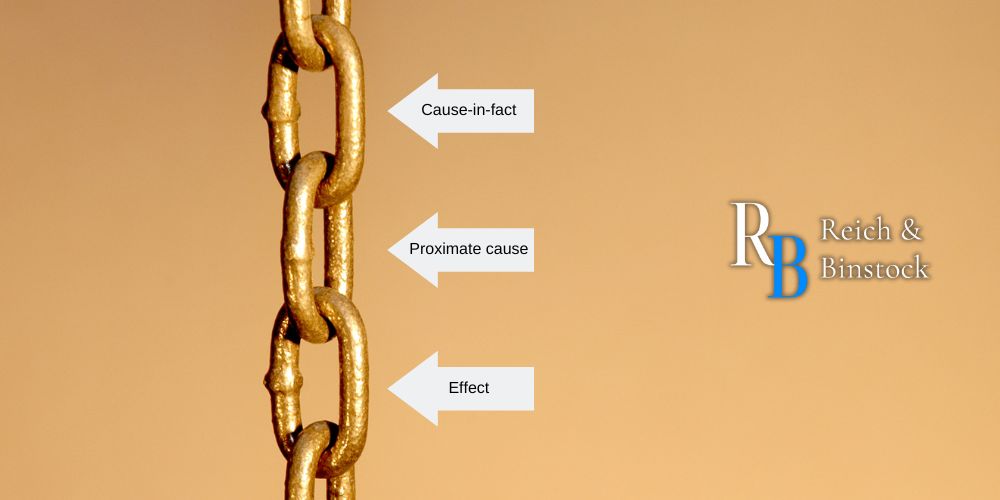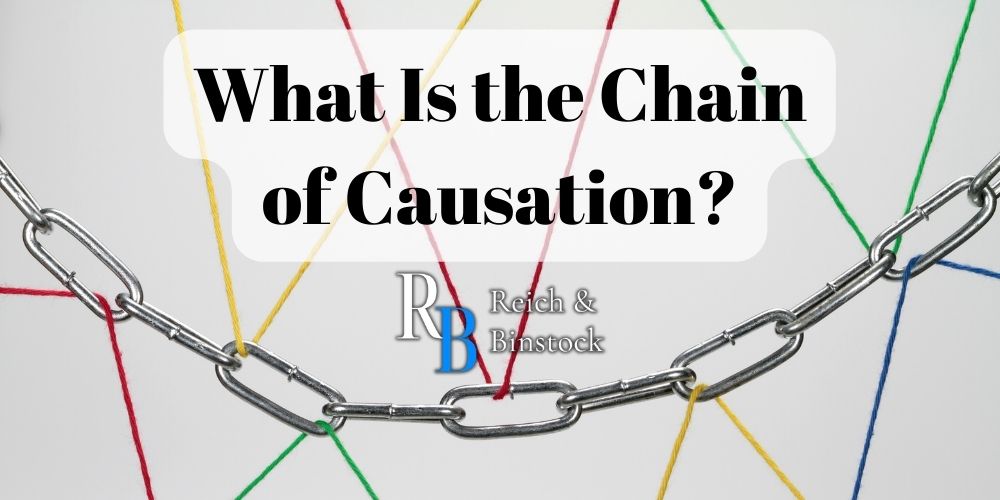The chain of causation is a common legal term that explains how the elements of negligence link together in a personal injury claim. To hold a defendant liable for negligent actions or lack of action, the causation chain must be complete. Terms like these can be confusing without training in personal injury law, but we’re here to demystify such legal terms.
In this blog, the Houston personal injury lawyers at Reich & Binstock explain what the chain of causation is and how it applies to personal injury cases. It is crucial to prove negligence if you want your personal injury case to succeed, and our attorneys can help you do that. To schedule a free, no-obligation consultation with us, please call our office at 713-622-7271 today.
What Is Negligence?
Negligence is a legal term that refers to someone’s failure to act in the same way that a reasonable person would in a similar situation. It can be present with both actions and inactions. A negligent person is someone who does not employ a reasonable amount of caution or care in a particular situation. If a negligent person is responsible for your injuries, they could be held liable for your resulting damages.
Negligence is crucial in a personal injury case, but it is not always as straightforward as it seems. For example, let’s think of a car accident case in which one driver rear-ends another driver. In rear-end car accidents, the fault is usually placed on the driver of the rear vehicle. However, it is not always so simple.
Maybe the car accident occurred because the rear vehicle suffered an auto defect, such as brake failure. In this case, the fault could lie with the mechanic who improperly installed the brakes.
Another element of negligence is called reasonable foreseeability. Reasonable foreseeability implies that the defendant did foresee or should have foreseen that their actions could have resulted in an accident or injury.
In the case of a drunk driving accident, for example, it is clear that the drunk driver acted negligently. This is because they knew that driving under the influence would impair their judgment, which could cause an accident.
Foreseeability is what keeps the chain of causation from being broken, which is why it is so crucial to show in personal injury cases.
What Are the Elements of a Negligence Claim?
To establish liability and negligence in a personal injury claim, a plaintiff must prove four elements. The four elements of a negligence claim are a duty of care, breach of the duty of care, injuries or damages, and proof of negligence.
Duty of Care
The duty of care is an individual’s responsibility to act with reasonable care and caution as a reasonable person would in a similar situation.
Breach of the Duty of Care
When someone violates the duty of care by acting unreasonably or failing to act reasonably, this breaches the duty of care they owe to others. Remember that negligence can result from either action or inaction.
Actual Damages
That breach must result in actual injuries or damages to another person or people. Damages could include physical injuries, property damage, medical bills, lost wages, and more.
Proof That Negligence Caused the Damages
Lastly, the plaintiff must establish a causal relationship between the first like (duty of care) and the last link (damages). In other words, they must show proof that the defendant’s breach of the duty of care directly led to harm or injury to the plaintiff.
What Is Causation?
Legal causation is the relationship between cause and effect in a personal injury claim. As with negligence and foreseeability, causation can be difficult to prove without help from an attorney. Even if you can prove negligence, this is not enough for a successful injury claim. You must also establish causation.
There are two aspects of causation that are important to understand. These aspects are cause-in-fact and proximate cause. While causation is also present in criminal law, its elements look different in personal injury law.
Successful cases involving negligence, injuries, and wrongful death must prove both aspects of causation. Cause-in-fact refers to the facts of the case. These facts prove that the defendant is liable for causing harm to the plaintiff.
Intent is irrelevant in these cases. Regardless of whether the defendant intended to cause injuries to another person, something bad happened due to their actions.
Proximate causation, on the other hand, is a bit more complex. It involves questioning whether or not the harm would have occurred without the proximate cause. It must also be a direct cause of the harm in question.
To determine proximate causation, we must ask the question, “Is it reasonable to conclude that the defendant knew or should have known that their negligent actions could have or would cause injury?”
What Is the Chain of Causation?

The chain of causation is the sequence of events that make up and link the cause and effect of a case. An action of the defendant causes an effect, which is the plaintiff’s injury. The entire chain of causation must remain intact for a successful negligence claim. If something interrupts the chain of causation, negligence cannot be proven.
The first link of the chain is one cause, followed by other causes that lead to the effect. If there is an interruption of the chain of causation, the connection between cause and effect becomes too murky for a clear case. An unbroken chain of causation relies on the foreseeability of the defendant’s actions, as we mentioned before.
Examples of Chain of Causation
Your personal injury case is unique, and the facts of the case will not exactly match another case. However, the necessary elements for a successful negligence case remain the same. No matter how badly you are injured or how much damage has been done, each link in the chain of causation must be proven alongside reasonable foreseeability.
Below, we outline an example of the chain of causation in a personal injury case.
- Cause: The defendant drinks too much alcohol and becomes intoxicated.
- Cause: The defendant gets in their car to drive home while intoxicated.
- Effect: The defendant gets into a car accident and severely injures the other driver.
It was reasonably foreseeable that the defendant’s actions could have led to an accident that caused injuries. Therefore, the chain of causation is unbroken.
Examples of Breaking the Chain of Causation
Below, we outline an example of an interruption of the chain of causation.
- A customer spills a drink in the middle of a grocery store aisle.
- The store manager puts out a wet floor sign to warn other customers of the danger.
- A different customer folds up the sign and hides it out of sight.
- Someone slips and falls on the wet surface, breaking their wrist in the process.
In this case, the store manager could not be held liable for the customer’s broken wrist. They could not have foreseen that another customer would move the wet floor sign. The moving of the sign was the interruption in the chain of causation.
How Might the Chain of Causation Affect Your Personal Injury Claim?
In your personal injury case, you must be able to prove all the elements of an unbroken chain of causation. If the defendant attempts to dodge liability by claiming that some other intervening cause led to your injuries, this can complicate your case. This is why working with an attorney is so crucial for negligence claims.
Proving that the chain of causation remains unbroken can be difficult on your own. However, an experienced attorney will have what it takes to gather evidence to support your claim. We will ensure that your voice is heard and that your right to just compensation is protected.
Contact a Personal Injury Attorney with Reich & Binstock Today
If you or someone you love suffered injuries due to another person’s negligence, you need the skilled personal injury attorneys at Reich & Binstock. We have decades of experience in our field, and we have what it takes to fight for the compensation you deserve. To schedule a free consultation with us, please call our Houston law firm at 713-622-7271 today.














